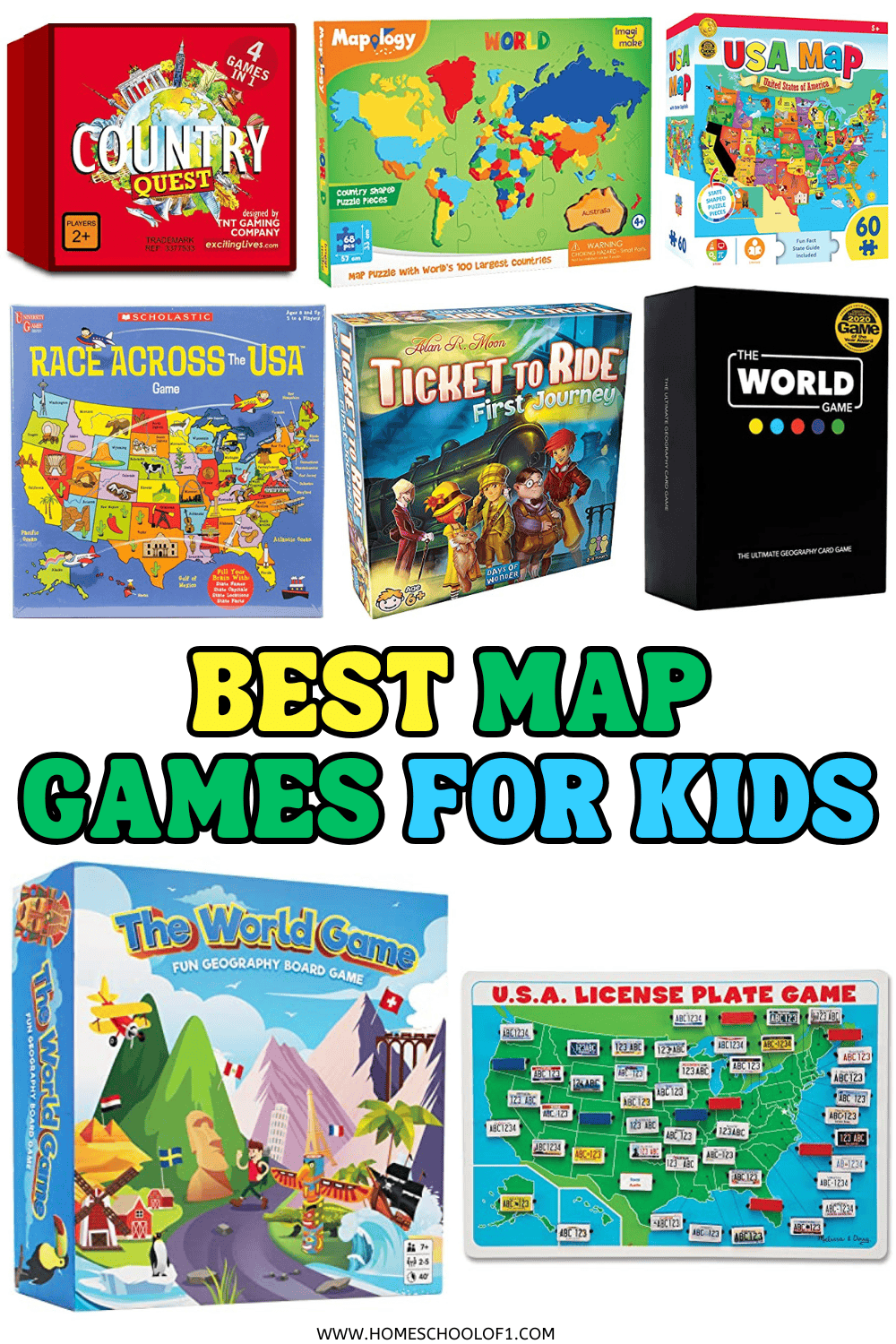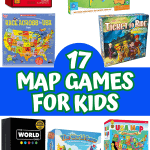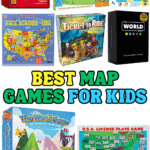Fun and Educational Map Games for Kids to Explore
Map games for kids have been one of the easiest ways I’ve snuck geography into our game nights over the years.
Whether we’re racing across the U.S. with trivia cards or piecing together a world map on the floor, these games make learning about countries and states feel like play — not school.
Some of our favorite discoveries have come from simple board games that sparked questions about capitals, landmarks, and even time zones.
If your kids love puzzles, competition, or just need something hands-on to connect with geography, this list of our go-to map games might be exactly what you need.

**This post may contain affiliate links. As an Amazon Associate and a participant in other affiliate programs, I earn a commission on qualifying purchases.**
Geography Map Games That Made a Real Difference for Us
Over the years, we’ve tried everything from state trivia to continent puzzles — and not every game has been a hit.
The ones that stuck?
They balanced learning with just the right amount of fun. These geography-themed board games, puzzles, and card games work for a wide range of ages, from preschoolers to tweens and beyond.
Some focus on U.S. states, others on world geography, but all of them have helped bring maps to life in a way that’s engaging and hands-on.
This was one of the first geography games we tried, and it still gets laughs. The mix of quirky state cards and silly challenges keeps it light while helping kids memorize state names and capitals without it feeling like flashcards.
We paired this with our state facts printable and suddenly U.S. geography wasn’t just another subject — it was a fast-paced card game we played after dinner.
If your kids are too young for the original Ticket to Ride, this version is a great starting point. The routes are shorter, and the artwork is bright enough to pull in even reluctant players.
Ours loved planning train routes and learning where major cities like Chicago or New York are located — all while secretly working on their strategic thinking.
This one turned out to be a surprise hit on rainy afternoons. It’s a trivia-style board game that manages to sneak in lots of state facts without feeling like a quiz.
My son loved the competitive aspect — racing across the board while shouting out answers about capitals and landmarks.
We used it alongside our geography Scattergories for extra fun.
This card-based geography game packs in more info than you'd expect. It's great for kids who already know a bit about the world and want to go deeper — countries, flags, capitals, landmarks, the whole deal.
What I love most is that it's super portable, so we’ve even played it in the car on road trips. It's been a solid addition to our collection of educational board games
This one's ideal for visual learners. The board itself is a U.S. map, and the questions are all tied to specific states — from identifying shapes to recognizing key landmarks.
It helped reinforce what we’d already been covering in our U.S. history unit, and because it’s so interactive, it didn’t feel like schoolwork.
We brought this along on a long road trip and it kept my son busy through multiple states. The wooden board is sturdy, and flipping the license plates as you spot them adds a tactile element that’s great for younger kids.
It naturally opens up conversations about where states are located and what they're known for — way more engaging than just handing them a map.
This puzzle was a big hit when we first started introducing continents and countries. The chunky pieces are just right for little hands, and the bright visuals make it easy to remember where each country belongs.
It gave us a reason to talk about places we’d read about in books, and it’s one of the few puzzles that actually stays interesting over time.
I grabbed this set when we were diving into world geography, and it was worth every piece. With puzzles for different regions like Europe and Africa, it broke down the world in a way that felt manageable.
We’d do one region a week and talk about the countries while putting them together — it turned into a low-pressure, high-interest geography lesson without a worksheet in sight.
We used Country Quest as a supplement when my son started getting curious about flags and capitals. It’s a trivia-style game but feels more like a challenge than a test.
The cards are colorful and packed with info, and it worked well both one-on-one and in small groups when cousins visited. Great for kids who already have a little background knowledge and want to level up.
This was our go-to when my son was younger and we were just beginning to explore basic world geography. It’s simple enough for preschoolers but still engaging thanks to the lift-and-learn feature.
The animal illustrations sparked all kinds of conversations — from penguins in Antarctica to elephants in Africa — which made it more than just a puzzle.
Use our free printable continents worksheet too!
If you want something that goes a little deeper into state facts, this board game is a solid pick. It’s a bit more structured than Scrambled States but still fun.
We used it to reinforce what we were learning with our U.S. coloring pages, and the combination really helped things stick.
It’s definitely more trivia-based, so best for older elementary kids and up.
Looking for something more advanced?
If you’re shopping for older kids, check out our favorite geography games for middle school — they offer more challenge, deeper strategy, and are great for reinforcing more complex geography skills.
This puzzle is great if you’re short on space — we kept it on the fridge for a while and would work on it in small chunks. The magnetic pieces make it mess-free, and it’s perfect for visual and tactile learners.
Over time, just from piecing it together repeatedly, my son picked up the states, their shapes, and even a few capitals.
This was a fun twist on traditional flat puzzles. Building the 3D version gave us the chance to talk about where countries are in relation to one another — and the mini landmarks made it extra memorable.
It’s definitely a more hands-on option, and it worked well when my son needed a break from textbook learning but still wanted something engaging.
We pull this out regularly for family game night. It’s fast-paced and surprisingly competitive, which keeps my son interested.
The game is based around collecting countries from each continent, and I love that it reinforces both memorization and quick thinking.
If you have multiple kids, this one works great in small groups and has enough challenge to grow with them.
Yes, this is technically the same brand as the earlier card version, but the board game version adds a whole new layer. It’s a bit more structured, with a travel-around-the-world style of gameplay.
We found it helpful for tying in flags, capitals, and even cultural facts — and it’s one of those games where even adults learn something new.
This puzzle set is more detailed than most, which makes it better for older kids. My son loved adding the little flag stickers, and it sparked questions about why certain flags look the way they do.
It was a good way to go beyond “where is this country” and into “what’s unique about this place?” A solid combo of geography and curiosity.
This puzzle uses state-shaped pieces, which turned out to be a brilliant design choice. My son picked up the shapes of states without even realizing it — and started noticing them on road signs and maps after.
It’s a tactile, self-correcting way to build U.S. geography skills that sticks far better than any worksheet we’ve tried.
Map games are great for a wide range of ages — from simple puzzles for preschoolers to strategy-based board games for tweens and teens. Most games on this list work well for ages 4–12, with some extending into the middle school years.
Absolutely. We’ve used map games as a fun way to reinforce geography lessons without relying on worksheets. They’re hands-on, encourage critical thinking, and often lead to deeper conversations about the world.
The World Game (card version) is our top pick for travel. It’s compact, packed with facts, and easy to play in the car, at hotels, or while waiting for food at restaurants.
Last Updated on 3 April 2025 by Clare Brown



















